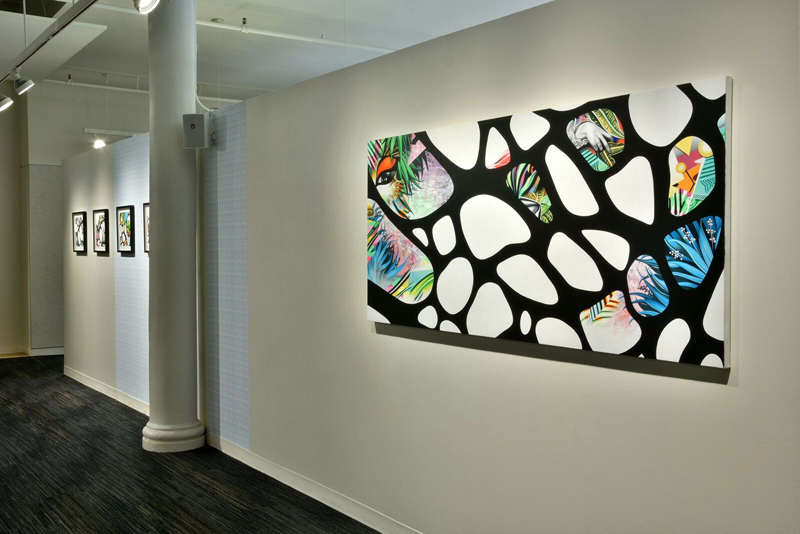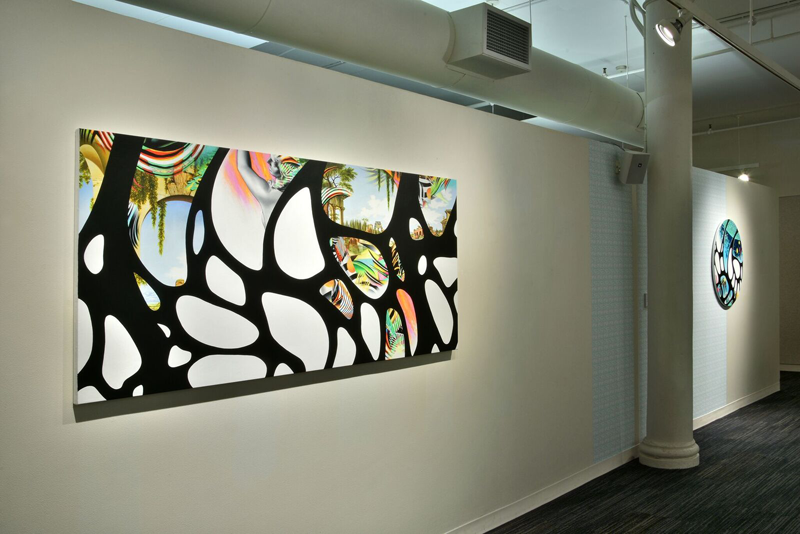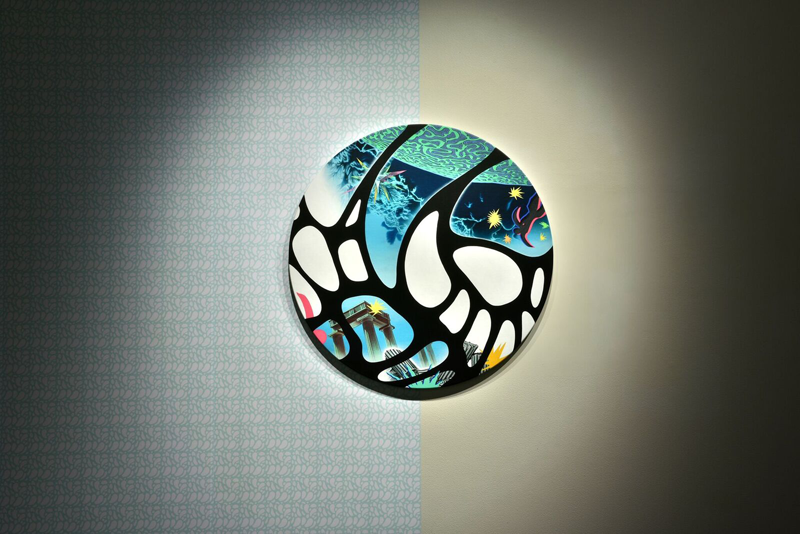by Andrew H. Sullivan
December 19, 2017
Ventanas are windows in Spanish, are framed spaces literally, a border surrounding an empty space through which we can see into one room or environment from another, let in air, let in light, frame our perspective, deliver access prevent entrance; are portholes or windshields or skylights or clerestories, slits as in embrasures (to let our arrows), and, these days, many come in the shape of rectangles and are mainly rigidly geometric, glass protected, or celled or double paned or bullet proof though some open or roll down or swing. The framing of windows, often enough, affects how we experience the things we see, obstructing the world outside of that particular space. Some are open. Some shuttered. Some clouded. Others stained.
Access and exclusion.
When I heard Peter Gerakaris had a new, kind-of-secret exhibition in the gallery space cum common area cum entrance to a cool architecture firm, FXFOWLE, in the flat iron district of NYC I had to check it out. I’d covered an installation of Gerakaris’ around the same time last year, Floating Garden at the Surrey Hotel on 76th and Madison. I loved that work and, sadly, it came down only a couple weeks after I managed to view it. (You can check out the essay and artist interview here) What struck me about the art was its whimsy and conscientiousness. The two coexisting was odd and striking and a perfect fit for the setting, so I expected, amongst other things, such as professional craftwork and mucho consideration, a similar marriage of opposites, replete with a dynamic sense of tension. Torsion. Flambé. Daring. Diversity. Color.

Two walls defined the exhibition space, on either side of which myriad architects sketched and plotted. Overhead hung jet black piping with black molding around the hanging lights that, as it turns out, unintentionally communicated with the black spaces of the work. I say spaces but I mean windowing or, actually, I mean honeycombing. Imagine several related though disparate scenes from western art history, from pre-western antiquity, from an amalgamation of the two projected through a historically minded artist’s imagination. Erect a black honeycomb, not quite geometric, a bit off, over the top of the scene, the in-between spaces acting as windows, in some cases, acting as covers, a thick gooey white with a bit of shine representing the “through” space, sort of limbo, or, thinking of covers, a shield. They’re both through-the-space and covering-the-space, opaque and pellucid.
Three main pieces in all Eden, Babylon, and Atlantis tondoI stood in front of each for a good while, taking in the effect at close and long range, trying to assert myself into the work and take from it that pound of emotional or intellectual flesh that I tend to extract as a reward. But the work was slippery. The effect of the through-the-window or obscured-by-the-window jarringin a good way. These pieces were, like Gerakaris’s earlier work, challenging, and I liked that. What feels good about this sort of challenge is that the opening stages of access are rewarding. The next tier of access becomes more difficult and the final stages of access, without the help of the artist, perhaps, impenetrable. But if you’re able to access the deeper, hidden meanings, you’re rewarded handsomely.
Between the black, curling around it sometimes, appeared shapes and scenes, color and intrigue, human forms and abstractions, a glimpse at a Hellenic building, an homage to a Bernini statue, and the encroachment of nature, or, in the case of Atlantis Tondo, the submerging of anti-chaos under water, or a surreal being with a sketched human hand in the piece called Eden. Conflict abounds and each conflict yields a different tension, a new story, a similar experience though not repeated. Classic Gerakaris with the images borrowed from architecture and designs around the world, particularly in coloration and the requisite Japanese forms, hidden but present, the diagonal lines, and, new for me, renaissance art and mythos.
A quick impression of each piece.
Eden: Closing my eyes then opening them, I was drawn to the elfish figure popping out of grass and reeds, or maybe the face is reemerged from a pool of sunset-reflecting water, else the sky, with a fierce red eye shadow and green hair like plants. I tracked over to the right and down, taking in the fantasy-like landscape with blue vegetation and a mélange of hotter colors rounding out the forest or jungle glimpses. Gerakaris referred to the collection as vignettes, but each honeycomb ventana in each separate work, the ones with subject matter in them anyway, acts like its own micro-vignette, a flash visual fiction that builds on the other flash fictions around it to form a larger narrative. Throwing me off a bit, there was a study of a hand sketched as if from charcoal near the top right. If the painting is Eden, then the feminine hand belongs to, certainly, Eve—and then I suppose the spirit in the corner is Eve as well, or else Eve’s id. A studied hand gives way to a wild face, lost in a version of paradise, cut in a ventana web, whitespace occluding the center of the canvas.

Atlantis: The blue and porthole-like aspect to this piece drew me in long before I could attempt my fresh-look experiment with shutting my eyes. The canvas is round so viewing the work in this case, to me, approximated the view I might find being in a submarine, only, in Gerakaris’s sea, a chunk of coral fills the above space and an ancient Greco-Roman ruin the seabed. The narrative of lostness was present in Atlantis as was a sort of personal lostness, being submerged and all. The honeycomb ventanas, as in Eden add to the mystery of the space, almost as if it were the physical projection of a partially remembered dream.
—I’ll slash into my own article a bit about the diagonals and the anti-space, which, in this instance, refers to the space outside of the work. Because, Gerakaris created an anti-space by considering the present space of the exhibition, again, as he did for the Surrey piece, using the surroundings as influence to communicate his idea with the patron’s experience and thus a symbiosis of form, color, and revelry. The firm was a bit less rapturous of a space than the Surrey Hotel, so, we had the black ventanas mirroring the industrial black of the light fixtures and piping. But, what this liminal essay space is about is the wall paper that Gerakaris created from scratch and lined the exhibition walls with in shocks of blue gray sheets, bridging spaces between paintings. There’s always a communication happening, a world beyond the work drawing you into the work pulling you out of it. Is it meta, is it meticulous, is it gallerist, is it a crutch? It’s everything and nothing, just some pretty paper, a bow, maybe no one notices it. It’s a dare, really. And I loved it—

Babylon: This complement to Eden takes a moment to appreciate. The story and tension in Babylon is of a historical nature, of time. There’s Greco-Roman architecture in ruin with the orange-green-yellow-blues of Eden’s “jungle” aspects encroaching everywhere. This is the past with the ghostly homage to a Bernini statute representing the beings that once were there. Everything is in transition, from the past to a present moment of semi-revitalization headed to a future of complete natural takeover and maybe even inundation, as in Atlantis. The ventana effect here reminds us of what we don’t know or have forgotten, that history is incomplete, that even present moments are incomplete and never fully experienced.
Studies: Four “studies” 16”x16” act as a stepping stone to the larger pieces, in a way, with images in the larger works appearing in microcosm, the colors, too, and also some colors that don’t appear that reflect on perhaps previous installations and modes of thinking—one in particular jumps out with Japanese motifs. The studies are an echo; they command less attention initially, the viewer tending toward the large pieces and the center of the installation wall, and so are seen later, as an afterthought, after-effect. And the effect is pleasing, like dessert, and you’ll want to take one home.
The glasses! You have to have these, though the painting were not made for them, Gerakaris is crafty even with himself and somehow between a honeycombed synapse through a dendron pane cross a nook under a nook behind a nook covered by some wall paper, there, in Gerakaris’ Cretan brain, lay a subconscious hidden-to-him thought that stowed away via electric impulse to the fingers during his color application and viola, these glasses give us glare, give us shine, add another dimension to the thoroughly dimensionified work. I had to make my rounds again to get the full effect and it worked. I saw some of the insight in fuller color, in more apparent conflict, and also, importantly, I just enjoyed the dazzle.
These works are so enjoyable that I wondered if people will fail to recognize their complexity and the density of thought contained within? No matter. I think Gerakaris wants the low and high brow, the intellectual and aesthete. I think he courts both, dangerously so. In that is tension. In that is a type of enthusiasm for art that a lot of work, for me, lacks. Pop and intellect married.

Now, I had Peter with me after my initial go through keening his sweet sapho nothings into my ear as I got lost on several occasions. He brought me straight but other times led me purposely astray, or so I feel. He wanted me to earn it. And so, I’m both confident in my assertions that they are true to intent at the same time that I’m sure I got a unique and impossible to repeat experience—which means, nothing is real and I saw what I could see in the window and you will see what you can see and, who knows, the windows might be open or closed for you depending on your train ride over, if you had to stop short on your bike, or if you’re just there for a bit of fuck all fun. There’s a beauty in that chaos. And now I’m back to wondering if Gerakaris had this in mind all along.
What a shame that Ventana, too, like Floating Garden, was temporary. I got there the week it was scheduled to close but we can now see the same exhibition (Ventana 2.0) gracing the Googlers at the NYC headquarters with a significant and, I’m told, serendipitous curatorial upgrade, which, by means of diptych, connects Eden’s right side to the left side of Babylon. Also, if you’re feeling particularly daring this winter, you can check out a portion of this exhibit, an origami Ventana at Wave Hill, inside the museum. I recommend it. If you can catch Gerakaris on a day when he’s visiting his sites, which, from conversation, he seems to often these projects are truly dear to him and that paternalism comes across in the details, in its presentation, absolutely be sure to ask for the glasses and chat him up. He’s a willing rhetorician, being Greek and all, and you’ll be treated to bespoke art access. I’ll be following Gerakaris and look forward to a big project in development for the spring. If only ventanas could act as hyperspace doorways for passing through, I’d willingly lurch through one Gerakaris Ventana to another, Atlantis to Eden to Babylon to...what I hear rumors of next: a project of gold leaf and owls in the vein of Byzantine icons.
Ps. It’s important to know that these pieces are all visible on Peter’s website if you can’t make it to see them in person, which I encourage readers to do.
Transcending Passages, Maisoon Al Saleh, March 16th - April 6th, 2021
Unbound Perspectives - SEPTEMBER 26-OCTOBER 17, 2020
East Villager Billy The Artist Climbs Atop Ai Wei Wei's Fence To Shine A Light On It
A Quick Note on Transplants: Greek Diaspora Artists
The Inner Strength of Joan Didion
Basquiat—The Unanswerable Answer to the Art World
Let’s talk about the hard stuff: Get Out
May It Last: A Portrait of the Avett Brothers
Move Over Hogwarts—The Practical Magic Is at Headfort
The Dog Days of Summer—Two Ways to Beat the Heat
The Mistress, the Publisher, His Son & His Mother
Santoalla-- the Spaces Between
Reading Arthur Miller in Tehran, The Salesman
Killing the ISIS Propaganda Machine, City of Ghosts
Bewitched, Bothered and Beguiled, The Beguiled– A Film Review
A Spoonful of Sugar-- Not Saccharine The Big Sick: A Film Review
Fiona and the Tramp, Lost in Paris- a review
Movie Review: Beatriz at Dinner
Cameraperson, dir. Kristen Johnson: stories from behind the camera lens
SELFISH, Review by Heather Zises
Winter on Fire: Ukraine’s Fight For Freedom, dir. Evgeniy Afineevsky
Strange Days directed by Kathryn Bigelow (1995)
World of Tomorrow and the Quit-Bang Language of the Future
Quintet, Directed by Robert Altman, 1979
Classic Movie Short Review: Croupier (1998)
Popeye, Directed by Robert Altman, 1980
What We Do in the Shadows by Jemaine Clement and Taika Waititi
